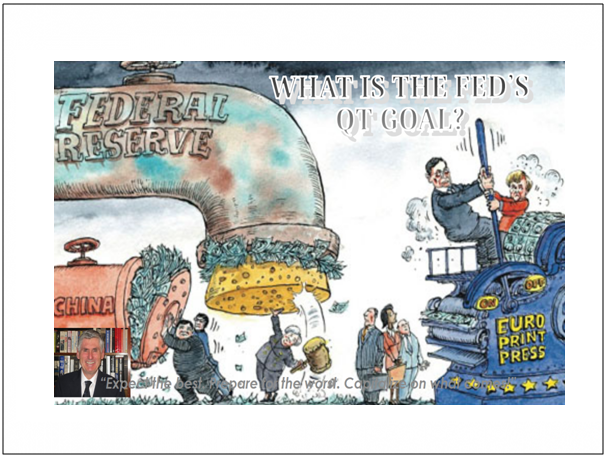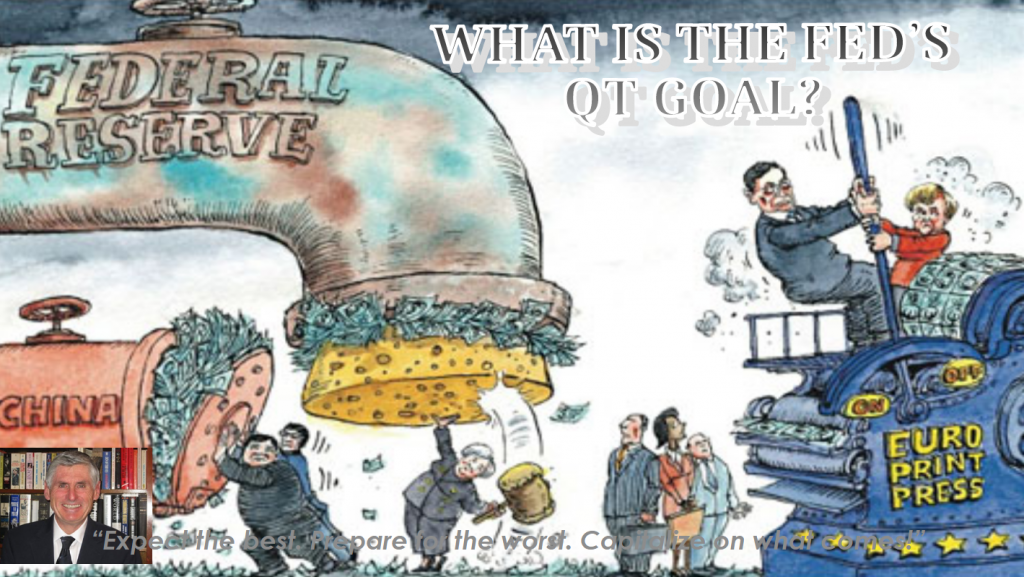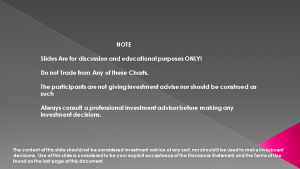IN-DEPTH: TRANSCRIPTION - UnderTheLens - 10-25-23 - NOVEMBER – What Is the Fed’s QT Goal?
SLIDE DECK
TRANSCRIPTION
SLIDE 2
Thank you for joining me. I'm Gord Long.
A REMINDER BEFORE WE BEGIN: DO NO NOT TRADE FROM ANY OF THESE SLIDES - they are COMMENTARY for educational and discussion purposes ONLY.
Always consult a professional financial advisor before making any investment decisions.
SLIDE 3 - COVER
Last week the Yield Curve as represented by the difference between the 30Y US Treasury Bond and the 2 Year Treasury Bill attempted a “Un-Inversion”. A coming recession is signaled by an Inverted Yield Curve, BUT it is when the yield curve begins steepening that the market knows the recession is near. That is the significance of the Un-Inversion.
The question is what does that exactly mean to the Fed’s current Quantitative Tightening Program?
SLIDE 4
When should we expect it to stop as the potential recession unfolds and what would the Fed’s Balance Sheet then reflect? That should help answer a number of questions about the level of Debt to GDP then Fed has on its Balance Sheet that plays into the strength of the US dollar to protect itself from the long discussed and expected accompanying “Pivot”.
As such I would like to examine the following subjects outlined here.
SLIDE 5
The Key Messages I would like you to leave this video with are the following.
SLIDE 6
KEY MESSSAGES
- Though the Federal Reserve appears to be near, if not already at, the end of its rate hiking cycle we should expect policy tightening to likely to continue as the Fed shrinks its balance sheet through "Quantitative Tightening" (QT).
- The Fed stopped reinvesting securities on its balance sheet in June of last year. The central bank's assets have since shrunk by roughly $1 trillion to $7.9 trillion. Most of that reduction has been through lower holdings of Treasury securities (which is down $841 billion), while Mortgage-Backed Securities (MBS) have fallen by $228 billion. Of course offsetting these declines has been a rise in lending related to the emergency Bank Temporary Funding Program or BTFP which was created in response to the spring banking crisis.
- Accounting wise, a reduction in assets must be matched by an equivalent decline in liabilities. The primary channels for shrinking liabilities through QT have occurred through reduced bank reserves and reverse repurchase agreements.
- What has occurred is that bank reserves have fallen by a scant $17 billion. By far the biggest reduction on the liability side of the Fed's balance sheet has been Reverse Repurchase Agreements (RRPs), which have plunged by $728 billion.
SLIDE 7
KEY MESSSAGES
- So how much longer is QT likely to continue, and how large could the Fed's balance sheet be when it ends? The answer largely boils down to:
- One, the outlook for the U.S. economy,
- Second, the stickiness of RRP balances and
- Three, what the Fed considers an "ample" level of reserves.
- The most likely Base Case is for a recession next year which leads the Fed to cease QT at the start of Q3- The Fed's balance sheet by then should level off at around $7.2 trillion.
- We see the level of bank reserves as the key driving force in determining the "equilibrium" size of the balance sheet. In light of the 2017-19 QT episode, we can assume that reserves of around 8% of GDP is when the balance sheet reaches "equilibrium.
- This would be roughly equivalent to a sustained 50 bps increase in the Fed Funds rate. All else equal, this implies a 50 bps-higher 10-year Treasury yield and adds to a variety of other factors also putting upward pressure on longer-term yields.
SLIDE 8
I posted this graphic in last week’s subscriber Technical Analysis newsletter. With the 3month-30Y Treasury having begun to steepen in January we know historically that the curve tends to begin steepening first and this is approximately 5 months before the recession.
Since July we have seen weakening equity markets which normally occurs after the last Fed Rate hike which may turn out to have been July.
SLIDE 9
Separately we know the US Treasury Bond market has experienced a historic drop in value as yields have spiked. The real fallout from this in our opinion has yet to be fully experienced!
This chart suggests the recession may be already underway and as usual becomes official a few quarters after the fact!
SLIDE 10
So what should the Fed do or maybe more to the point is what will the Fed actually do?
SLIDE 11
In our opinion the Fed is locked into the understanding of how Fed Chairman Paul Volcker beat the Inflation of the 1970’s.
As I have written about before it wasn’t just about raising rates to unprecedented levels of 16%+(which the Fed at 5.5% isn’t even close to achieving – nor ever will be) but more importantly how he had already started reducing financial market liquidity when he was President of the powerful NY Fed before being called to Chair the Federal Reserve to stop the inflation debacle.
This is what the Fed is trying to do with QT amongst also trying to protect the value of the US dollar!
SLIDE 12 - HOW MUCH LONGER WILL QT REMAIN?
So knowing this how long will QT remain? Shouldn’t it be stopped to combat the recession getting too deep? Or, is inflation really the bigger problem and excess liquidity being its real driver??
SLIDE 13
As we are all aware, the marked rise in inflation that commenced in 2021 led the Federal Open Market Committee (FOMC) to tighten U.S. monetary policy considerably since early 2022. Not only has the FOMC raised its target range for the federal funds rate by 525 bps since March 2022, but it also has allowed the central bank's balance sheet to shrink since June of last year under "Quantitative Tightening" (QT).
We suspect the Open Market Committee has finished its rate-hiking cycle especially since the recent surge in Treasury Yields is doing the work of the Fed having to raise rates further. Fed governors are already on the record acknowledging this.
Although the FOMC may not raise its target range for the federal funds rate again, we do expect the Committee to allow the Fed's balance sheet to shrink further in coming months. If so, then the overall stance of monetary policy will become even more restrictive as QT continues.
SLIDE 14
Before we discuss the likely outlook for the central bank's balance sheet going forward, we need to first highlight what has transpired over the past 16 months since the balance sheet run-off began.
The Fed's balance sheet has receded from a high of nearly $9 trillion in April 2022 to just under $8 trillion at present, although not in a straight as shown here as a percentage of GDP. As we will discuss in more detail, the balance sheet shot up by nearly $400 billion in mid-March 2023 when tensions roiled the nation's banking system due to the failure of some regional commercial banks.
Tensions in the banking system were short-lived due, at least in part, to actions that the Federal Reserve took at that time. The size of the Fed's balance sheet began to decline again in late March, and it has subsequently remained on a downward trend.
SLIDE 15
Because U.S. Treasury securities and mortgage-backed securities (MBS) account for the vast majority of the Fed's assets, any meaningful reduction on the left side of the central bank's balance sheet will need to occur via lower holdings of these securities.
The FOMC announced in May 2022 that it would allow up to $30 billion worth of U.S. Treasury securities and up to $17.5 billion worth of MBS to roll off the Fed's balance sheet per month starting in June 2022.
The FOMC subsequently increased the size of these monthly caps to $60 billion and $35 billion, respectively, beginning in September 2022.
In total, $841 billion worth of Treasury securities have rolled off the central bank's balance sheet since QT began, while MBS holdings have declined by $228 billion over the same period.
The total assets of the Federal Reserve have declined by less than this combined amount because the central bank acted to fulfill its lender-of-last resort responsibilities in the spring of this year. Specifically, the Fed provided loans to some commercial banks when they experienced liquidity difficulties in the wake of the regional bank failures as triggered by the Silicon Valley Bank (SVB). Some of these loans have subsequently matured or been repaid, but the amount of outstanding loans on the central bank's balance sheet still totals roughly $170 billion.
SLIDE 16 - UNDERSTANDING THE LIABILITY SIDE
Now, for the liability side of the Fed’s balances Sheet.
SLIDE 17
Of course, a reduction on the left side of an institution's balance sheet (i.e., its assets) must be matched by an equivalent decline on the right side (i.e., its liabilities and net worth).
A clear understanding of the Fed's liabilities is crucial when thinking about the evolution of the balance sheet's size in coming months and years. The central bank's four largest liabilities at present are
- Federal Reserve notes (i.e., paper currency in circulation),
- The deposits that commercial banks hold at the Federal Reserve (i.e., bank reserves),
- Reverse repurchase agreements (i.e., cash parked overnight at the central bank by a variety of financial institutions, most commonly money market funds) and t
- The general account of the U.S. Treasury Department (i.e., the federal government's "checking account" at the central bank) referred to as the TGA.
Federal Reserve notes were historically the largest item on the liability side of the central bank's balance sheet. As shown here, currency in circulation tends to grow at a steady pace over the years as the U.S. economy expands. There is nearly $2.3 trillion worth of Federal Reserve notes outstanding today, and this amount likely will continue to grind higher in coming years in-line with, or perhaps a bit faster than, nominal GDP growth.
The general account of the U.S. Treasury Department (TGA) has also bounced around over the past few years. The TGA was about $820 billion in May 2022 right before the onset of QT. Since then, it has moved down to about $700 billion today. The TGA will swing around on a week-to-week basis as the government's financing needs ebb and flow, but our sense is that $650-$700 billion is about what Treasury is targeting over the medium term. As a result, we do not anticipate this being a big swing factor on the Fed's balance sheet in the quarters to come.
Consequently, any additional shrinkage on the liability side of the balance sheet will occur largely via:
- Commercial bank reserves and
- Reverse Repurchase agreements.
This chart importantly illustrates that bank reserves at the Federal Reserve were miniscule prior to the financial crisis.
Bank reserves exploded during the financial crisis when the central bank implemented quantitative easing (QE) to provide more monetary support to the rapidly contracting economy. The Fed bought Treasury securities and MBS from banks and financed these purchases by crediting the deposit accounts of those banks. The security purchases increased the size of the Fed's assets while the equivalent rise in bank reserves increased the size of the central bank's liabilities.
SLIDE 18
As the Fed's holdings of Treasury securities and MBS have subsequently declined, so have the reserves of the commercial banking system at the central bank, although perhaps by less than one might think. Bank reserves have declined by just $17 billion since QT began in June 2022.
SLIDE 19
Before the pandemic, the value of reverse repurchase agreements (RRPs) on the central bank’s balance sheet was a relatively small $250 billion or so. However, starting in 2021, RRP balances began to climb rapidly, mushrooming to $2.2 trillion by May 2022 and hitting an all-time high of nearly $2.7 trillion in April 2023.
- Robust inflows into money market mutual funds,
- Declining T-bill supply,
- The rapid pace of Fed Funds rate hikes and regulatory considerations
All drove RRP balances higher.
However, an explosion of T-bill supply in recent months and a much slower pace of rate hikes has helped push RRP balances down to $1.5 trillion.
SLIDE 20
To recap, the value of Federal Reserve notes outstanding has risen since May 2022 while bank reserves, the Treasury's General Account and reverse repos have all declined on balance over the same period, with the latter category seeing the biggest decline since QT began 16 months ago.
SLIDE 21
What is this suggesting about when QT will end and what is the Fed’s likely goal?
SLIDE 22
Our base case is that QT will run through the end of Q2-2024 as our earlier assessment indicated is likely, at which point we expect balance sheet runoff to cease as the economy slips into an obvious and quickly deepening recession and the FOMC pivots from rate hikes to rate cuts.
The reality is the FOMC is unlikely to continue passive monetary policy tightening via QT during a period of negative GDP growth, rising unemployment and material cuts to the federal funds rate.
Under this scenario, we would expect the Fed's balance sheet to level off around $7.2 trillion or so for the foreseeable future, with MBS runoff eventually resuming, perhaps in 2025 or 2026.
SLIDE 23
Holding the size of the balance sheet flat would theoretically allow the Fed to "grow into" its balance sheet as a share of GDP. Unless the economy nosedives into a deep recession, the FOMC is not likely to restart QE purchases of securities.
But, what if there is no recession and the U.S. economy achieves a "soft landing “as the consensus now believes? Under this scenario, the FOMC likely would still cut the federal funds rate in an effort to slowly move monetary policy toward a more neutral setting.
However, this pace of easing likely would occur much more gradually than in the recession scenario, and it strikes us as plausible that the FOMC would continue QT simultaneously. This in turn would allow the FOMC to attempt to return the balance sheet to roughly its "equilibrium" size. Chair Powell suggested this could be a possibility under the right circumstances during his press conference at the conclusion of the July 25-26 FOMC meeting.
In the long-run, the equilibrium size of the Fed's balance sheet is determined by demand for the Federal Reserve's liabilities, e.g. public demand for paper currency and demand for bank reserves held at the central bank. In its May 2022 statement on plans for reducing the size of its balance sheet, the FOMC stated that "over time, the Committee intends to maintain securities holdings in amounts needed to implement monetary policy efficiently and effectively in its ample reserves regime."
This statement suggests that, like the 2017-2019 QT period, the level of reserves is the key driving force of balance sheet projections.
Put another way, the FOMC wants bank reserves to be plentiful, but not too plentiful.
SLIDE 24 - PROJECTING SIZE OF BALANCE SHEET
Let’s try projecting the actual size of the balance sheet when QT ends.
SLIDE 25
The 2017-2019 QT episode is illustrative for thinking about when the Fed's balance sheet might reach its equilibrium size. In the 2010s, bank reserves peaked at roughly $2.8 trillion (~15% of GDP) in Q1-2015.
By Q3-2019, bank reserves had halved to $1.4 trillion (6.6% of GDP) amid declining security holdings and growth in non-reserve liabilities, such as currency in circulation.
SLIDE 26
It was at this point in September 2019 that money market rates, such as the federal funds rate and the Secured Overnight Financing Rate (SOFR), spiked dramatically in a sign that reserves were no longer as "ample" as they appeared. The stress in money markets prompted a quick reaction by the Federal Reserve that included purchasing Treasury bills and lending via repurchase agreements.
By the end of 2019, money market rates largely had normalized, and reserves had risen to about $1.7 trillion (7.5% of GDP).
In light of that episode, it is a reasonable assumption that at present, bank reserves are "ample" above $2.2 trillion (8% of GDP) and "scarce" below that threshold. Admittedly, there is significant uncertainty around this estimate.
Bank demand for highly-liquid, safe assets could be higher or lower compared to 2019 for a variety of reasons. That said, it is a reasonable starting point for scenario analysis, and it is similar to the underlying assumptions used by the Federal Reserve Bank of New York and other analysts.
We also assume that the FOMC will first slow the pace of QT for a couple of quarters before stopping it altogether. This would be consistent with what occurred during the 2017-2019 QT period as well as the guidance given by the Committee in May 2022.
With this piece of the foundation laid, we can begin to build up to an equilibrium balance sheet size by making some assumptions about expected growth in non-reserve liabilities. As discussed earlier,:
- Currency in circulation totals $2.3 trillion at present, and we expect it to grow at a fairly linear trend going forward.
- We assume that currency in circulation will grow roughly 8% per year, in line with the average from 2016-2019.
- The Treasury's General Account is around $650 billion, and we assume that it will remain more or less unchanged around this level for the foreseeable future.
This leaves reverse repurchase agreements as the biggest remaining swing factor in the equation. At present, RRPs on the Fed's balance sheet total $1.5 trillion, with $290 billion held by foreign official institutions (e.g., foreign central banks), and the remaining $1.2 trillion of the RRP balance owned by money market funds and other miscellaneous financial institutions. Foreign official RRP balances, which are a part of the FIMA Repo Facility, stood at roughly $250 billion before the pandemic, so they have returned to approximately normal levels. But the remaining RRP balances, which are a part of the ON RRP Facility, were near zero in 2019. How sticky these funds are (or are not) will be critical to estimating the size of the Fed's balance sheet in coming years.
SLIDE 27
We considered three scenarios to give us a range of estimates regarding the size of the Fed's balance sheet in coming quarters.
- In the first scenario, we assume that ON RRP balances are "sticky" and that they remain near their current level of $1.0 trillion. (We assume that the RRP balances of foreign official institutions remain constant at their current level of $300 billion or so in each of the three scenarios). With RRP balances remaining elevated, bank reserves would drain away from the system relatively quickly in coming months. Under this scenario, we project the FOMC would stop QT at year-end 2024. The balance sheet would recede to only $7 trillion or so
- In the second scenario, we assume that ON RRP balances shrink all the way back to their pre-pandemic level of essentially zero. Under this second scenario, bank reserves drain away more slowly and don't become "scarce" until year-end 2025, which allow the central bank's balance sheet to shrink to roughly $6 trillion.
SLIDE 28
Our third scenario assumes that ON RRP balances ultimately recede to the halfway point between their current levels and zero (approximately $500 billion). Under this scenario, the balance sheet of the Federal Reserve shrinks to about $6.5 trillion through Q2-2025.
Note that once the balance sheet reaches its equilibrium size in all three scenarios, it begins to grow modestly again to keep reserves as a share of GDP steady and to accommodate growth in non-reserve liabilities such as currency in circulation.
SLIDE 29 - WHAT ARE THE IMPLICATIONS FOR YIELDS?
What are the implications for Yields?
SLIDE 30
The FOMC has undertaken QE to stimulate the economy at numerous points over the past 15 years. When the FOMC buys securities during QE, this additional source of demand puts upward pressure on the price of the bonds and downward pressure on their yields, all else equal.
QT runoff is passive and does not involve active sales, but the idea is similar: as the central bank reduces its holdings of Treasury securities and MBS, the additional supply of these securities puts upward pressure on intermediate and longer-term yields, all else equal.
Estimating the magnitude of QT's impact on yields is tricky. QT is a relatively new phenomenon, with the only other historical example the 2017-2019 periods. This stands in contrast with the FOMC's primary monetary policy tool, the federal funds rate, which has been used as a policy lever for decades. In addition, there are many others tricky factors that must be controlled for in the analysis, such as the role QE/QT play in forward guidance for the federal funds rate.
That said, the research literature suggests that $2.5 trillion of runoff is roughly equivalent to a 50 bps increase in the federal funds rate on a sustained basis.
In 10-year equivalent terms, the magnitude is similar.
SLIDE 31
In other words, if QT runs until mid-2025 and the Fed's balance sheet declines by about $2.5 trillion from peak to trough, then we would expect the 10-year Treasury yield to be roughly 50 bps higher than it otherwise would be, all else equal.
Estimates vary somewhat depending on the study and assumptions, and the actual impact could be a bit larger or smaller than 50 bps. That said, we think 50 bps is a reasonable base case. Although this effect is not huge, it is important to keep in mind that this period's QT is taking place as a variety of other factors are also putting upward pressure on longer-term yields.
SLIDE 32
The federal budget deficit has widened over the past year and is about two percentage points larger today than it was in 2019.
SLIDE 33
A deluge of Treasury supply from widening deficits and QT is occurring as markets consider the prospects of a "higher for longer" outlook for the federal funds rate and a possible shift higher in "r-star."
Against this backdrop, it is perhaps not surprising that medium- to longer-term Treasury yields are as high as they are today.
SIDE 34 – CONCLUSION
So what can we conclude?
The Fed has a plan and is working it pretty much as originally designed.
However, as with any plan there are developments out of its control and politics!
SLIDE 35
Politics is a big issue!
What can only be called Fiscal Insanity has taken over Congress. The extent and rate of increasing spending is something the Fed I believe never anticipated and seems helpless to influence.
Deficits at the current level of rates is an inflation driver the Fed may simply unable to handle?
Secondly the fact that US entitlement programs at the Federal, State and Local levels are both seriously underfunded and their assets are in maturing US Treasuries is a huge problem for the Fed and US Treasury! It has not been factored in to Fed policy and is a ticking time bomb.
Thirdly, inflation is a global problem which energy and food scarcity issues have yet be fully felt. Inflation is a long way from being solved and the Fed has only its balance sheet to fight the problem.
SLIDE 36
The simple problem is that the US debt is now growing at as faster rate than the economy.
SLIDE 37
As stagnation turns in stagflation the Fed simply does not have the tools to solve this problem.
We are headed for a debt crisis and the Fed knows it!
The best it can do is hope and pray since frankly it simply is ill equipped for what lies ahead.
Stopping QT and going back to QE will not be even close to what is required it our assessment!
SLIDE 38
As I always remind you in these videos, remember politicians and Central Banks will print the money to solve any and all problems, until such time as no one will take the money or it is of no value.
That day is still in the future so take advantage of the opportunities as they currently exist.
Investing is always easier when you know with relative certainty how the powers to be will react. Your chances of success go up dramatically.
The powers to be are now effectively trapped by policies of fiat currencies, unsound money, political polarization and global policy paralysis.
SLIDE 39
I would like take a moment as a reminder
DO NO NOT TRADE FROM ANY OF THESE SLIDES - they are for educational and discussions purposes ONLY.
As negative as these comments often are, there has seldom been a better time for investing. However, it requires careful analysis and not following what have traditionally been the true and tried approaches.
Do your reading and make sure you have a knowledgeable and well informed financial advisor.
So until we talk again, may 2023 turn out to be an outstanding investment year for you and your family?
I sincerely thank you for listening!






